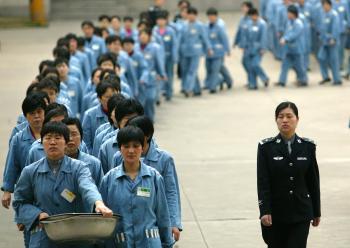
A report offering maps, information and directions to Chinese labour camps has been made available for journalists and tourists visiting Beijing for the Olympics. The Coalition to Investigate the Persecution of Falun Gong (CIPFG), an international advocacy group, has compiled the report, which lists labour camps kilometres from seven major Olympic sites in China – Beijing, Beijing Tuanhe, Qingdao, Shanghai, Tianjin, Qinhuangdao, and Shenyang.
The report titled “Torture Outside the Olympic Village: A Guide to China’s Labour Camps,“ includes phone numbers for the labour camps, as well as for the local ”surveillance offices” and details first hand experiences from former detainees.
Phil Glendinning, director of the Edmund Rice Centre and Spokesman for the CIPFG in Australia, says the report is “vital reading” for anyone going to China, most particularly journalists.
“Any journalist going to China needs to have access to the fullness of the truth otherwise they are going with only half the story,,” he told the The Epoch Times.
People reading the report would be “shocked and disgusted” when they realise what is going on within close proximity to Olympic venues, he said, and it was important to realise that the Olympics had been chosen with the idea of improving conditions for Chinese people.
“The rest of the world can’t be supping at that table unless the rest of the world is prepared to help the Chinese and tell them the truth.”
First hand accounts
Conditions within the camps, the products made through forced labour and a number of show tours have been documented in the report, much of it through first-hand accounts.
However, it is the descriptions of tortures endured that are most chilling, confirming the statement from Amnesty International that it continues to receive regular reports of “torture and other cruel, inhuman or degrading treatment taking place in RTL facilities”.
“I was shocked with six electric batons by five policemen while tied up on a bed board,” says Zhao Ming, who was held at Tuanhe from July 2000 to March 2002 and is now a post-graduate student at Dublin’s Trinity College. Beijing Tuanhe is located some 50km from Beijing.
Mrs Chen Ying, a Falun Gong practitioner who was also incarcerated at Tuanhe, said: “I was locked up with over a dozen other Falun Gong practitioners in a cell that was about 12 square metres (130 square feet) in size. We did everything in this cell, including working, eating, drinking and using the toilet.”
Falun Gong practitioner Ms Jennifer Zeng, who was detained at Beijing Municipal Women’s RTL Camp (formerly Xin'an Women’s Labour Camp) – just over 30km from the Beijing airport and not far from the National Stadium known as the Bird’s Nest – describes part of her experience.
“I was forced to stand motionless with my head bowed, looking at my feet for 16 hours every day, while repeatedly reciting out loud the insulting labour camp regulations,” says Ms Zeng, who now lives in Australia and has since written a book about her experience titled Witnessing History: One Chinese Woman’s Fight for Freedom.
The biographies of those giving testimonies and their availability for interviews have also been provided in the report.
Investigation Important
While the report notes that the RTL camps contain drug addicts, political dissidents and petitioners, CIPFG has focused on the plight of Falun Gong practitioners.
It quotes the US State Department’s 2007 report on human rights in China, which states that “some foreign observers estimated that Falun Gong adherents constituted at least half of the 250,000 recorded inmates” in China’s vast labour camp system.
The UN Special Rapporteur on Torture, Manfred Nowak, who visited the Beijing Women’s Camp in 2005, is also quoted. In his 2006 UN report on torture, he estimated that Falun Gong practitioners accounted for 66 per cent of all alleged torture victims in China.
North American President of CIPFG Clive Ansley, who is a specialist in Chinese law and now China Monitor for Lawyers’ Rights Watch in Canada, said the CIPFG report had come about after repeated attempts by CIPFG members to investigate reports of organ harvesting from Falun Gong practitioners for profit in China.
“Since the first allegations of harrowing torture methods and deaths in custody emerged in 1999, through to more recent evidence of organ harvesting from prisoners of conscience, CIPFG members have repeatedly requested permission to enter China and investigate claims of abuse,” he says in the report’s foreword.
“Yet, on an equal number of occasions, these requests have been denied. And that is partially the importance of this guide – for it provides information to journalists travelling to China to take this rare opportunity of access to the country to conduct an investigation of their own.”
Mr Ansley says that while the chances that reporters will gain access to the sites listed in the report are slim, it was important that reporters are informed and “give voice to innocent Falun Gong adherents and other civil rights defenders who suffer torture and death only miles from where athletes celebrate victory.
“For giving them a voice is not only our duty as responsible global citizens,” he said, “it is also the true realisation of the Olympic spirit.”



